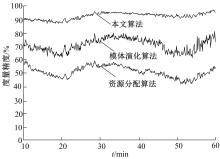吉林大学学报(工学版) ›› 2022, Vol. 52 ›› Issue (3): 626-632.doi: 10.13229/j.cnki.jdxbgxb20200798
• 计算机科学与技术 • 上一篇
基于Hadoop的跨社交网络局部时序链路预测算法
- 山西大同大学 计算机与网络工程学院,山西 大同 037009
Hadoop⁃based local timing link prediction algorithm across social networks
- School of Computer and Network Engineering,Shanxi Datong University,Datong 037009,China
摘要:
为了提高跨社交网络局部时序链路预测的精度和平稳性,提出了基于Hadoop的跨社交网络局部时序链路预测算法。该算法选取了6种跨社交网络节点相似性指标,采用Hadoop的核心组件MapReduce设计了一种并行运算模型,分割处理跨社交网络内的海量并行数据,降低了运算复杂度。运用基于MapReduce并行运算模型的局部时序链路预测算法和所选取的节点相似性指标,获得网络内点对间的预测分数值,实现了跨社交网络局部时序链路预测。实验结果表明,本文算法的预测精度较高,且能够保持平稳的预测状态,具有较好的综合预测性能。
中图分类号:
- TP311
| 1 | 吴铮, 于洪涛, 刘树新, 等. 基于信息熵的跨社交网络用户身份识别方法[J]. 计算机应用, 2017, 37(8): 2374-2380. |
| Wu Zheng, Yu Hong-tao, Liu Shu-xin, et al. User identification across multiple social networks based on information entropy[J]. Journal of Computer Applications, 2017, 37(8): 2374-2380. | |
| 2 | 任思禹,申德荣,寇月, 等. 话题感知下的跨社交网络影响力最大化分析[J]. 计算机科学与探索, 2018, 12(5): 741-752. |
| Ren Si-yu, Shen De-rong, Kou Yue, et al. Topic-aware influence maximization across social networks[J]. Journal of Frontiers of Computer Science & Technology, 2018, 12(5): 741-752. | |
| 3 | 何军,刘业政. 基于多维社交关系的在线社交网络链路预测研究[J]. 现代情报, 2017, 37(7): 41-46, 115. |
| He Jun, Liu Ye-zheng. Research on online social networks link prediction based on multidimensional social relations[J]. Modern Information, 2017, 37(7): 41-46, 115. | |
| 4 | 钱付兰, 杨强, 马闯, 等. 加权好友推荐模型链路预测算法[J]. 计算机科学与探索, 2019, 13(3): 383-393. |
| Qian Fu-lan, Yang Qiang, Ma Chuang, et al. Link prediction algorithm of weighted friend recommendation model[J]. Journal of Frontiers of Computer Science & Technology, 2019, 13(3): 383-393. | |
| 5 | 黄剑, 李明奇, 郭文强. 基于Hadoop的Apriori改进算法研究[J]. 计算机科学, 2017, 44(7): 262-266, 269. |
| Huang Jian, Li Ming-qi, Guo Wen-qiang. Reseach on Improved Apriori algorithm based on Hadoop[J]. Computer Science, 2017, 44(7): 262-266, 269. | |
| 6 | 温贺平, 禹思敏, 吕金虎. 基于Hadoop大数据平台和无简并高维离散超混沌系统的加密算法[J]. 物理学报, 2017, 66(23): 77-83. |
| Wen He-ping, Yu Si-min, Lv Jin-hu. Encryption algorithm based on Hadoop and non-degenerate high-dimensional discrete hyperchaotic system[J]. Acta Physica Sinica, 2017, 66(23): 77-83. | |
| 7 | 杜凡, 刘群. 有向动态网络中基于模体演化的链路预测方法[J]. 计算机应用研究, 2019, 36(5): 1441-1445, 1453. |
| Du Fan, Liu Qun. Link prediction method based on motif evolution in directed dynamic networks[J]. Application Research of Computers, 2019, 36(5): 1441-1445, 1453. | |
| 8 | 陆圣宇, 欧锋, 黄清元, 等. 基于资源分配与偏好连接的局部路径链路预测算法[J]. 计算机工程, 2019, 45(9): 316-320. |
| Lu Sheng-yu, Ou Feng, Huang Qing-yuan, et al. Local path link prediction algorithm based on resource allocation and preferential attachment[J]. Computer Engineering, 2019, 45(9): 316-320. | |
| 9 | 王珍, 韩忠明, 李晋. 大规模数据下的社交网络结构洞节点发现算法研究[J]. 计算机科学, 2017, 44(4): 188-192. |
| Wang Zhen, Han Zhong-ming, Li Jin. Research on social network structural holes discovery algorithm under large-scale data[J]. Computer Science, 2017, 44(4): 188-192. | |
| 10 | 江若然, 张玲玲. 社交属性网下基于链路预测及节点度的推荐算法[J]. 管理评论, 2019, 31(2): 119-129. |
| Jiang Ruo-ran, Zhang Ling-ling. Recommendation algorithm based on link prediction and node degree using a social-attribute network[J]. Management Review, 2019, 31(2): 119-129. | |
| 11 | 杨旭华, 俞佳, 张端. 基于局部社团和节点相关性的链路预测算法[J]. 计算机科学, 2019, 46(1): 155-161. |
| Yang Xu-hua, Yu Jia, Zhang Duan. Link prediction method based on local community and nodes ' relativity[J]. Computer Science, 2019, 46(1): 155-161. | |
| 12 | 冯译萱, 张月霞. 一种时序有向网络中的链路预测方法[J]. 计算机工程与应用, 2019, 55(21): 150-156. |
| Feng Yi-xuan, Zhang Yue-xia. Link prediction method in sequential directed network[J]. Computer Engineering and Applications, 2019, 55(21): 150-156. | |
| 13 | 厍向阳, 张玲. 基于Hadoop的FP-Growth关联规则并行改进算法[J]. 计算机应用研究, 2018, 35(1): 109-112. |
| She Xiang-yang, Zhang Ling. Parallel improved algorithm of FP-Growth association rules based on Hadoop[J]. Application Research of Computers, 2018, 35(1): 109-112. | |
| 14 | 张人杰, 胡超, 刘威. 空间延迟容忍网络中多链路数据拥塞控制算法[J]. 吉林大学学报: 工学版, 2020, 50(4): 1472-1477. |
| Zhang Ren-jie, Hu Chao, Liu Wei. Multi-Link data congestion control algorithm in spatial delay tolerance network[J]. Journal of Jilin University(Engineering and Technology Edition), 2020, 50(4): 1472-1477. | |
| 15 | 孙学波, 石飞达. 基于Hadoop的Apriori算法研究与优化[J]. 计算机工程与设计, 2018, 39(1): 126-133, 145. |
| Sun Xue-bo, Shi Fei-da. Research and optimization of Apriori algorithm based on Hadoop[J]. Computer Engineering and Design, 2018, 39(1): 126-133, 145. | |
| 16 | 雷建云, 彭媛, 孙翀, 等. 一种社交网络环境下并行短文本查询算法[J]. 中南民族大学学报: 自然科学版, 2018, 37(3): 123-128. |
| Lei Jian-yun, Peng Yuan, Sun Chong, et al. A parallel short text query algorithm in social network environment[J]. Journal of South-Central University for Nationalities(Natural Science Edition), 2018, 37(3): 123-128. | |
| 17 | 高杨, 张燕平, 钱付兰, 等. 基于三元闭包的节点相似性链路预测算法[J]. 计算机科学与探索, 2017, 11(5): 822-832. |
| Gao Yang, Zhang Yan-ping, Qian Fu-lan, et al. Link prediction algorithm based on node similarity of triadic closure[J]. Journal of Frontiers of Computer Science & Technology, 2017, 11(5): 822-832. | |
| 18 | 张维维, 何家峰, 高国旺, 等. 基于博弈论的无线Mesh网络路由与信道分配联合优化算法[J]. 吉林大学学报: 工学版, 2018, 48(3): 887-892. |
| Zhang Wei-wei, He Jia-feng, Gao Guo-wang, et al. Wireless Mesh network routing and channel allocation union optimization algorithm based on game theory[J]. Journal of Jilin University(Engineering and Technology Edition), 2018, 48(3): 887-892. |
| [1] | 曲优,李文辉. 基于锚框变换的单阶段旋转目标检测方法[J]. 吉林大学学报(工学版), 2022, 52(1): 162-173. |
| [2] | 赵宏伟,霍东升,王洁,李晓宁. 基于显著性检测的害虫图像分类[J]. 吉林大学学报(工学版), 2021, 51(6): 2174-2181. |
| [3] | 刘洲洲,张倩昀,马新华,彭寒. 基于优化离散差分进化算法的压缩感知信号重构[J]. 吉林大学学报(工学版), 2021, 51(6): 2246-2252. |
| [4] | 孙东明,胡亮,邢永恒,王峰. 基于文本融合的物联网触发动作编程模式服务推荐方法[J]. 吉林大学学报(工学版), 2021, 51(6): 2182-2189. |
| [5] | 王生生,陈境宇,卢奕南. 基于联邦学习和区块链的新冠肺炎胸部CT图像分割[J]. 吉林大学学报(工学版), 2021, 51(6): 2164-2173. |
| [6] | 任丽莉,王志军,闫冬梅. 结合黏菌觅食行为的改进多元宇宙算法[J]. 吉林大学学报(工学版), 2021, 51(6): 2190-2197. |
| [7] | 林俊聪,雷钧,陈萌,郭诗辉,高星,廖明宏. 基于电影视觉特性的动态多目标实时相机规划[J]. 吉林大学学报(工学版), 2021, 51(6): 2154-2163. |
| [8] | 姚引娣,贺军瑾,李杨莉,谢荡远,李英. 自构建改进型鲸鱼优化BP神经网络的ET0模拟计算[J]. 吉林大学学报(工学版), 2021, 51(5): 1798-1807. |
| [9] | 赵宏伟,张子健,李蛟,张媛,胡黄水,臧雪柏. 基于查询树的双向分段防碰撞算法[J]. 吉林大学学报(工学版), 2021, 51(5): 1830-1837. |
| [10] | 曹洁,屈雪,李晓旭. 基于滑动特征向量的小样本图像分类方法[J]. 吉林大学学报(工学版), 2021, 51(5): 1785-1791. |
| [11] | 孙小雪,钟辉,陈海鹏. 基于决策树分类技术的学生考试成绩统计分析系统[J]. 吉林大学学报(工学版), 2021, 51(5): 1866-1872. |
| [12] | 张萌谡,刘春天,李希今,黄永平. 基于K⁃means聚类算法的绩效考核模糊综合评价系统设计[J]. 吉林大学学报(工学版), 2021, 51(5): 1851-1856. |
| [13] | 王春波,底晓强. 基于标签分类的云数据完整性验证审计方案[J]. 吉林大学学报(工学版), 2021, 51(4): 1364-1369. |
| [14] | 欧阳丹彤,刘扬,刘杰. 故障响应指导下基于测试集的故障诊断方法[J]. 吉林大学学报(工学版), 2021, 51(3): 1017-1025. |
| [15] | 钱榕,张茹,张克君,金鑫,葛诗靓,江晟. 融合全局和局部特征的胶囊图神经网络[J]. 吉林大学学报(工学版), 2021, 51(3): 1048-1054. |
|
||




